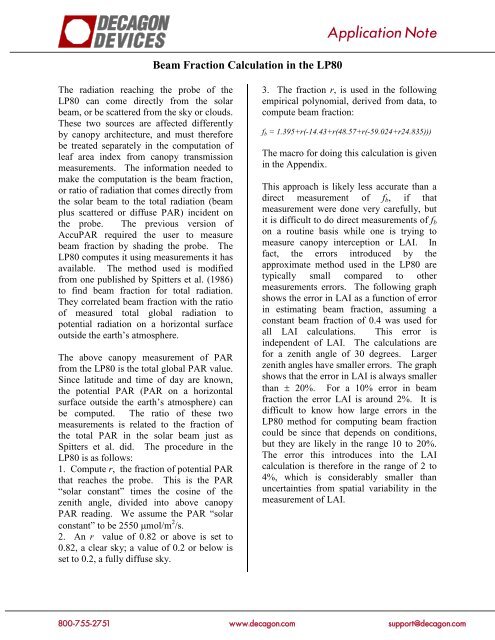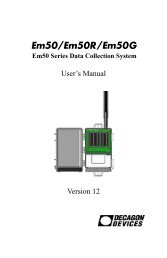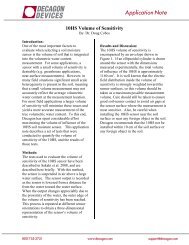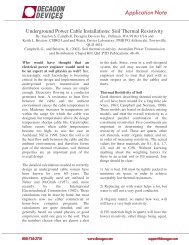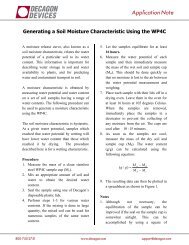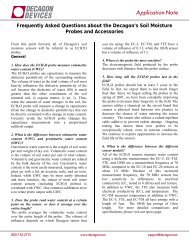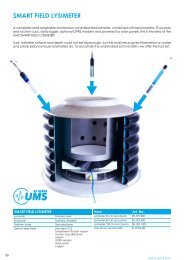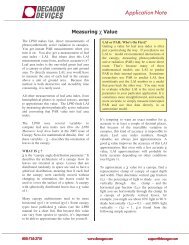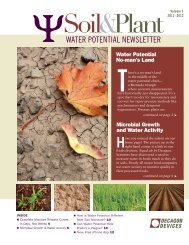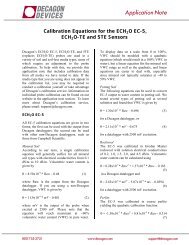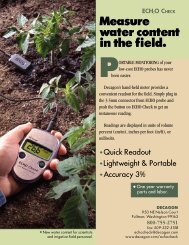Beam Fraction Calculation in the LP80 - Decagon Devices, Inc.
Beam Fraction Calculation in the LP80 - Decagon Devices, Inc.
Beam Fraction Calculation in the LP80 - Decagon Devices, Inc.
You also want an ePaper? Increase the reach of your titles
YUMPU automatically turns print PDFs into web optimized ePapers that Google loves.
<strong>Beam</strong> <strong>Fraction</strong> <strong>Calculation</strong> <strong>in</strong> <strong>the</strong> <strong>LP80</strong><br />
Application Note<br />
The radiation reach<strong>in</strong>g <strong>the</strong> probe of <strong>the</strong><br />
<strong>LP80</strong> can come directly from <strong>the</strong> solar<br />
beam, or be scattered from <strong>the</strong> sky or clouds.<br />
These two sources are affected differently<br />
by canopy architecture, and must <strong>the</strong>refore<br />
be treated separately <strong>in</strong> <strong>the</strong> computation of<br />
leaf area <strong>in</strong>dex from canopy transmission<br />
measurements. The <strong>in</strong>formation needed to<br />
make <strong>the</strong> computation is <strong>the</strong> beam fraction,<br />
or ratio of radiation that comes directly from<br />
<strong>the</strong> solar beam to <strong>the</strong> total radiation (beam<br />
plus scattered or diffuse PAR) <strong>in</strong>cident on<br />
<strong>the</strong> probe. The previous version of<br />
AccuPAR required <strong>the</strong> user to measure<br />
beam fraction by shad<strong>in</strong>g <strong>the</strong> probe. The<br />
<strong>LP80</strong> computes it us<strong>in</strong>g measurements it has<br />
available. The method used is modified<br />
from one published by Spitters et al. (1986)<br />
to f<strong>in</strong>d beam fraction for total radiation.<br />
They correlated beam fraction with <strong>the</strong> ratio<br />
of measured total global radiation to<br />
potential radiation on a horizontal surface<br />
outside <strong>the</strong> earth’s atmosphere.<br />
The above canopy measurement of PAR<br />
from <strong>the</strong> <strong>LP80</strong> is <strong>the</strong> total global PAR value.<br />
S<strong>in</strong>ce latitude and time of day are known,<br />
<strong>the</strong> potential PAR (PAR on a horizontal<br />
surface outside <strong>the</strong> earth’s atmosphere) can<br />
be computed. The ratio of <strong>the</strong>se two<br />
measurements is related to <strong>the</strong> fraction of<br />
<strong>the</strong> total PAR <strong>in</strong> <strong>the</strong> solar beam just as<br />
Spitters et al. did. The procedure <strong>in</strong> <strong>the</strong><br />
<strong>LP80</strong> is as follows:<br />
1. Compute r, <strong>the</strong> fraction of potential PAR<br />
that reaches <strong>the</strong> probe. This is <strong>the</strong> PAR<br />
“solar constant” times <strong>the</strong> cos<strong>in</strong>e of <strong>the</strong><br />
zenith angle, divided <strong>in</strong>to above canopy<br />
PAR read<strong>in</strong>g. We assume <strong>the</strong> PAR “solar<br />
constant” to be 2550 µmol/m 2 /s.<br />
2. An r value of 0.82 or above is set to<br />
0.82, a clear sky; a value of 0.2 or below is<br />
set to 0.2, a fully diffuse sky.<br />
3. The fraction r, is used <strong>in</strong> <strong>the</strong> follow<strong>in</strong>g<br />
empirical polynomial, derived from data, to<br />
compute beam fraction:<br />
f b = 1.395+r(-14.43+r(48.57+r(-59.024+r24.835)))<br />
The macro for do<strong>in</strong>g this calculation is given<br />
<strong>in</strong> <strong>the</strong> Appendix.<br />
This approach is likely less accurate than a<br />
direct measurement of f b , if that<br />
measurement were done very carefully, but<br />
it is difficult to do direct measurements of f b<br />
on a rout<strong>in</strong>e basis while one is try<strong>in</strong>g to<br />
measure canopy <strong>in</strong>terception or LAI. In<br />
fact, <strong>the</strong> errors <strong>in</strong>troduced by <strong>the</strong><br />
approximate method used <strong>in</strong> <strong>the</strong> <strong>LP80</strong> are<br />
typically small compared to o<strong>the</strong>r<br />
measurements errors. The follow<strong>in</strong>g graph<br />
shows <strong>the</strong> error <strong>in</strong> LAI as a function of error<br />
<strong>in</strong> estimat<strong>in</strong>g beam fraction, assum<strong>in</strong>g a<br />
constant beam fraction of 0.4 was used for<br />
all LAI calculations. This error is<br />
<strong>in</strong>dependent of LAI. The calculations are<br />
for a zenith angle of 30 degrees. Larger<br />
zenith angles have smaller errors. The graph<br />
shows that <strong>the</strong> error <strong>in</strong> LAI is always smaller<br />
than ± 20%. For a 10% error <strong>in</strong> beam<br />
fraction <strong>the</strong> error LAI is around 2%. It is<br />
difficult to know how large errors <strong>in</strong> <strong>the</strong><br />
<strong>LP80</strong> method for comput<strong>in</strong>g beam fraction<br />
could be s<strong>in</strong>ce that depends on conditions,<br />
but <strong>the</strong>y are likely <strong>in</strong> <strong>the</strong> range 10 to 20%.<br />
The error this <strong>in</strong>troduces <strong>in</strong>to <strong>the</strong> LAI<br />
calculation is <strong>the</strong>refore <strong>in</strong> <strong>the</strong> range of 2 to<br />
4%, which is considerably smaller than<br />
uncerta<strong>in</strong>ties from spatial variability <strong>in</strong> <strong>the</strong><br />
measurement of LAI.<br />
800-755-2751 www.decagon.com support@decagon.com
Application Note<br />
LAI Error (Percent)<br />
25<br />
20<br />
15<br />
10<br />
5<br />
0<br />
-5<br />
-10<br />
-15<br />
-20<br />
y = 0.1801x + 2.0852<br />
R 2 = 0.9808<br />
-100 -50 0 50 100<br />
<strong>Beam</strong> <strong>Fraction</strong> Error (Percent)<br />
Reference<br />
Spitters, C. J. T., H. A. J. M Toussa<strong>in</strong>t and J. Goudriaan. 1986. Separat<strong>in</strong>g <strong>the</strong> diffuse and direct<br />
component of global radiation and its implications for model<strong>in</strong>g canopy photosyn<strong>the</strong>sis. Part I.<br />
Components of <strong>in</strong>com<strong>in</strong>g radiation. Agric. Forest Meteorology 38:217-229.<br />
Appendix: Visual BASIC macro for comput<strong>in</strong>g beam fraction<br />
Function <strong>Beam</strong><strong>Fraction</strong>(Zenith As S<strong>in</strong>gle, PAR As S<strong>in</strong>gle) As S<strong>in</strong>gle<br />
Const pi = 3.14159<br />
Dim r As S<strong>in</strong>gle, b As S<strong>in</strong>gle<br />
Zenith = Zenith * pi / 180<br />
If Zenith > 1.5 Then<br />
b = 0# 'nighttime<br />
Else<br />
r = PAR / (2550# * Cos(Zenith)) '600 w/m2 * 4.25 umol/w/m2 (.235 MJ/mol)(600 is potential<br />
PAR)<br />
If r > 0.82 Then r = 0.82<br />
If r < 0.2 Then r = 0.2<br />
b = 48.57 + r * (-59.024 + r * 24.835)<br />
b = 1.395 + r * (-14.43 + r * b)<br />
End If<br />
<strong>Beam</strong><strong>Fraction</strong> = b<br />
End Function<br />
13469-01 © 2009 <strong>Decagon</strong> <strong>Devices</strong>, <strong>Inc</strong>. All rights reserved.<br />
<strong>Decagon</strong> <strong>Devices</strong>, <strong>Inc</strong>.<br />
2365 NE Hopk<strong>in</strong>s Court<br />
Pullman, WA 99163<br />
support@decagon.com<br />
www.decagon.com<br />
800-755-2751 www.decagon.com support@decagon.com


